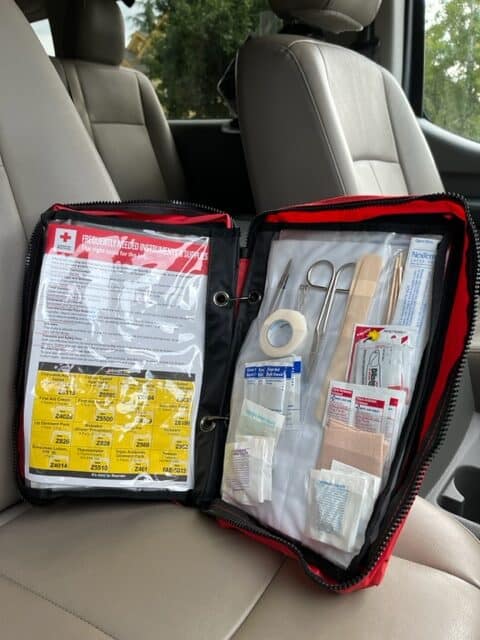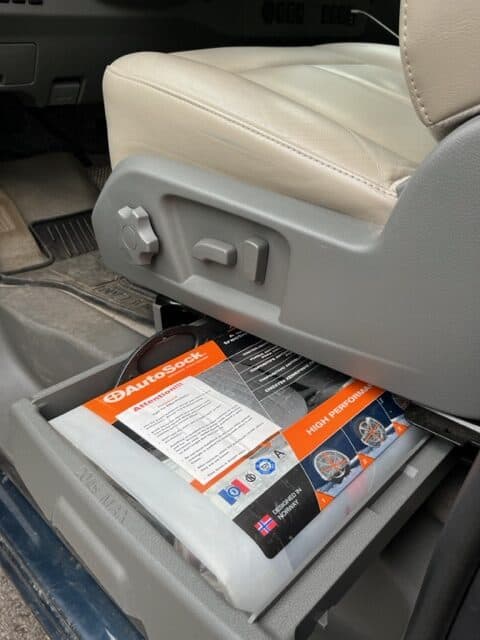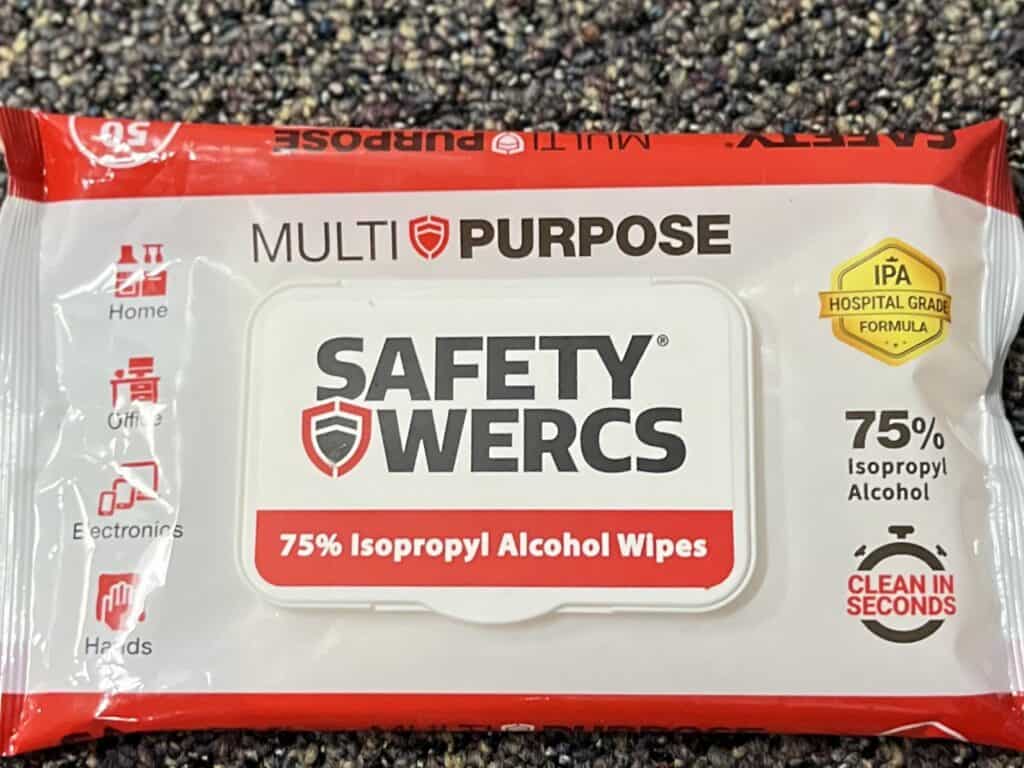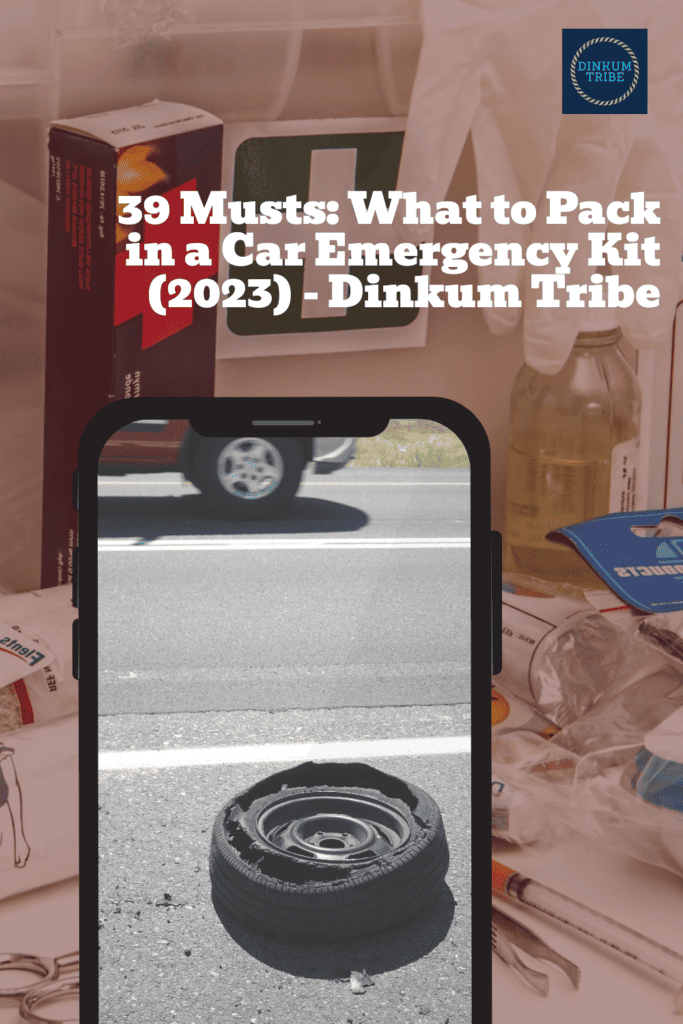Expect the Unexpected: What to Pack in a Car Emergency Kit
If you drive a vehicle, then you need to know what to pack in a car emergency kit. The good news is that there’s no lack of resources and tools to help you prepare for the unexpected.
Let’s consider what to pack in a car emergency kit before you take your next road trip. These 39 skills and supplies will prove helpful for small emergencies as well as worst-case scenarios.
This post contains affiliate links. As an Amazon Associate I earn from qualifying purchases made from the links on this site, at no extra cost to you. Thanks for supporting our family business!
Table of Contents
Do I Need to Know What to Pack in a Car Emergency Kit?

Yes. Emergencies take place on roadways every day, and their outcome is often determined by how they are handled.
Motorists are responsible for their own safety and the safety of their passengers. This responsibility not only requires safe driving but also adequate preparation for roadside emergencies.

The best roadside assistance service can’t replace your own preparation. Emergency services are hindered by distance, weather, and traffic before they can reach your location.
Remote areas and severe weather may prevent you from being able to contact emergency services for several hours. Proper training and a well-packed emergency kit are your first resources for navigating an emergency safely.
At a Glance: What to Pack in a Car Emergency Kit

Here’s a quick list of what to pack in a car emergency kit. The list below is only a starting point and should be added to according to the number of passengers and the nature of the trip.
- A safety-first mindset
- Designated storage for your car emergency kit
- 1 permanent marker
- 3 reflective triangles
- 1 fully-charged, mounted fire extinguisher
- 1 seat-belt knife
- First-aid training
- 1 First-aid kit
- Personal medical essentials
- 1 bottle of hand sanitizer
- 1 package of disinfectant wipes
- 1 roll of toilet paper and/or 1 package of moist toilettes
- Extra hygienic items
- 1 vehicle tool kit
- 1 multipurpose tool
- 1 roll of duct tape
- 1 compass
- 1 spare tire
- 1 wheel wrench
- 1 jack
- 1 set of tire chains
- 1 tire gauge
- 1 pair of jumper cables
- 1 quart of engine oil
- 1 container of cat litter
- 1 snow brush / ice scraper
- 1 foldable shovel
- 1 reflective vest
- 1 rain poncho
- 1 set of bottled water
- 1 stash of high-energy snacks
- 1 flashlight with an extra set of batteries
- 1 lighter and/or waterproof matches
- 1 cell phone charger
- 1 set of warm clothing
- 1 emergency blanket
- 1 sleeping bag or bivy bag
- 1 set of emergency documents in a waterproof package
We’ll go over each of these items in detail in the next section.
What to Pack in a Car Emergency Kit: Item by Item

#1. A Safety-First Mindset
Your mindset is the most important factor in protecting yourself and your passengers. A driver’s attitude toward driving can have life-or-death consequences.
Really?
Wondering if this applies to you? Here are a few questions to consider:
- Do you keep enough gas in your tank so that you’ll be ready in the event of an emergency?
- How often do you inspect your car to ensure it’s working correctly?
- Do you adjust your mirrors and check your fuel level before you start driving?
These behaviors spring from a mindset that prioritizes safety. Unfortunately, most of us weren’t taught these habits when we first learned to drive.

Investing in a Safety-First Mindset
I don’t know about you, but my safety skills need an occasional tune-up. Here are four resources that can help you with a safety reset.
- Driver Tune-Up by Henry Ramirez provides an easy-to-read refresh of the habits that result in safe driving.
- Karl Schlimm’s Staying Alive on the Road provides a much more comprehensive treatment on safe driving.
- Roadside Survival by Walter Brinker provides real-world guidance on how to manage mechanical failures on the road.
- A Pocket Guide to Personal Safety was written by former US Secret Service Agent, Jesse Kierkegaard. This highly-rated book teaches you how to protect yourself from criminal activity in all aspects of life.
#2. Designated Storage

A car emergency kit must be organized and accessible. Your tools and supplies will be of little help to you if they are missing, damaged, or hard to get to.
My first car emergency kit was an overstuffed duffle bag that sat in my trunk. The bag turned out to be a nuisance to store and a hassle to use. Little wonder that I eventually abandoned it altogether.
Keep It Simple
Take a moment to review your car space and plan where and how you’d like your car emergency kit to work. It’s best to do this before purchasing any of the items on your emergency kit list.
A few items will need to be directly accessible to the driver and/or passengers. Fire extinguishers and seat belt knives are two tools that should be mounted to the car interior within easy reach of those who will need them.
Most items will need to be stowed in a designated place. A rear seat organizer can work well, as long as it won’t be tampered with by a child or pet.
Lidded trunk organizers are usually the best option because they not only contain your emergency items but also shield them from exposure to the sun, weather, and bored children. Most importantly, you’ll need to count the cost: the kit will take up some space and it won’t be available for everyday use.
#3. Permanent Marker

A permanent marker is the second item you’ll need to get started on your car emergency kit. Items like food and moist towelettes eventually expire, but your marker can help you keep tabs on your supplies.
Avoid the temptation to choose just any marker. Your car will be in all kinds of weather, so you’ll need ink that can stand up to time, sunshine, and inclement weather.
Keep your marker handy as you choose what to pack in your car emergency kit. Mark your name on each item, and a date on any items that will eventually need to be restocked.
What Items Should I Label in my Car Emergency Kit?
- Frequently used items (example: jumper cables)
- Items that expire (example: food, medications)
- Items that gradually dry out (example: moist towelettes)
I recommend writing the month and year (ex: 08/23) on each of these items even if they already come with an expiration date. Labels fade and fall apart, so you’ll be glad that you wrote the expiration date on the top of that medication cap!
#4. Reflective Triangles
Reflective triangles may be the most important (and most forgotten) emergency car kit tool. A stalled vehicle poses a significant threat to you and other motorists, especially if it remains unmarked.
The danger is even greater when the stall takes place in a location where visibility is limited. God help the person whose vehicle fails on a mountain curve, a slope, or in bad weather!
Place reflective triangles several yards before and after your vehicle so that drivers can see your stall and safely adjust their speed. Reflective triangles also alert people to your need for help and aid service providers in finding your location.
Pro Hack: Each state has its own rules about how and where reflectors are to be placed. Learn what your state requires and practice a dry run ahead of time. That way, you’ll be ready when the time comes to bust them out.
#5. Fire Extinguisher
Fire is a real risk when it comes to cars. Collisions and mechanical failures are reason enough to carry a fully-charged fire extinguisher.

That said, you’ll need to choose wisely. There are different kinds of fire and different extinguishers are used for different fires.
For example, water works great for a standard combustible fire. But what would happen if you put water on an electrical fire? (Don’t try it. NOT GOOD)
Look for an extinguisher that has a 2A 10BC rating. This kind of extinguisher handles a range of fire types that may occur on a vehicle. In fact, this is the extinguisher of choice for school buses.
#6. Fire Extinguisher Mount
A fire extinguisher isn’t much help if you can’t find it. Install a fire extinguisher mount inside your vehicle so that you can find it and use it in seconds.
#7. Seat Belt Knife
A seat belt can kill you. The same restraint that keeps you from flying through the windshield may also keep you from escaping the wreck.
Make sure to have at least one seat belt knife within your vehicle. The knife must be secured at a place that’s visible and within reach of the person who needs it.
#8. First-Aid Certification

First Aid Certification is one of the best gifts you can give to yourself and the people around you. Specialized training empowers you to offer immediate care even in worst-case scenarios.
Certification gives you the understanding and confidence to use a first-aid kit effectively. It also teaches you what to do when the best medical supplies are not at hand.
#9. First Aid Kit

First Aid allows you to provide immediate care as you wait for emergency services to arrive. A basic first-aid kit will include sterile gloves, antiseptic wipes, and a range of bandages and gauze.
These kits aren’t always easy to use, especially if you haven’t been trained in first aid. I recommend purchasing your kit and taking it to your first aid class so you can familiarize yourself with its contents and learn how to use your kit well.

#10. Personal Medical Essentials
A first-aid kit is only a starting point when it comes to emergency medical care. Each person has their own personal medical needs that will not be represented within a first-aid kit.
What are your personal medical needs? Are you far-sighted? Then you’ll need to add “prescription glasses” to your list of what to pack in your car emergency kit.

Do you require blood pressure medication? Be sure to have an extra supply stowed away as well.
Essential medication and medical information for you and your family should remain in the car at all times. You may not be alive or able to assist your children in a car emergency, so provide the items and instructions that emergency responders will need in order to help your children.
#11. Hand Sanitizer

Hand sanitizer allows you to clean your hands while also conserving your supply of drinkable water. Be sure to purchase sanitizer with no less than 60% alcohol content.
#12. Disinfectant Wipes

Cars are enclosed spaces that get germy fast. Your stash of disinfectant wipes will come to the rescue when someone throws up, pees their pants, or lets out a nasty sneeze.
People often confuse antiseptic wipes with disinfectant wipes, but only antiseptic wipes can be used on wounds. Your canister of disinfectant wipes allows you to conserve your antiseptic wipes for medical emergencies.
#13. Toilet Paper / Moist Towelettes

Don’t forget the most important papers! Your car may not breakdown near a restroom.
Toilet paper and moist towelettes can also be used for medical care or to clean up messes. You won’t regret having more options when you encounter an emergency.
#14. Extra Hygienic Items
Brushing your teeth doesn’t seem all that important in an emergency. However, good hygiene keeps you healthy and generally improves your mood.
Take a few minutes to pack a basic dopp kit stocked with what you’d need if your car was stalled for two days. Remember to pack what your children will need as well.
#15. Tool Kit
It’s tempting to count on a roadside assistance service for every vehicle emergency. But, there’s no guarantee that a tow truck will reach you quickly every time.
Winter storms can strand dozens of motorists faster than these services can respond to them. More than that, severe weather and remote roads can make phone contact impossible.
Obtain your own, well-stocked vehicle tool kit to keep in your car at all times. Take a day to learn how to perform basic emergency maintenance on your car.
Build your confidence by using your tools to change a tire and complete similar tasks in the safety of your garage. Then you’ll be better prepared to perform emergency car maintenance in less-than-ideal conditions.
#16. Multipurpose Tool
A multipurpose tool is a huge help in an emergency. It conserves time and energy when you need it most. It also doubles as a weapon.
You may not see how or when you’ll need your multipurpose tool, but that’s just the point. It’s most valuable when you’ve run into an obstacle and you’re short on options.
My Swiss Army knife is one of the few emergency kit items that I keep on my person at all times. I’ve found that my multipurpose tool works best when I have it with me and use it frequently.
I keep a second multipurpose tool stowed away in the emergency kit. Keeping a multipurpose tool on hand helps me to remember that I have it as an option.
#17. Roll of Duct Tape
Yesterday I drove on a freshly grated gravel road. The road was good, but it rattled my car like crazy.
After thirty minutes of bone-shaking driving, my rearview mirror shook free from its mount. It hung down from the mounting by a flimsy electrical wire.
Thankfully, I had duct tape. In less than a minute the mirror was taped on and I was back on the road.
Keep duct tape on hand for these kinds of problems. It looks tacky, but you can schedule that repair job after you get home safe and sound.
#18. Compass
If you haven’t noticed, this list chooses analog over digital. The reason for this is simple: analog is dependable and lasting.
An iPhone has a compass, but your phone’s energy is limited and needs to be conserved for making contact. The fuel that recharges your phone is better spent keeping you warm and getting you home.
Pack a compass so that you don’t have to rely on your phone. Practice navigating with your compass so that you can find your way even when times are tough.
#19. Spare Tire
Does your vehicle have a spare tire? Check your vehicle manual and locate your spare tire before making your next trip.
If your car doesn’t come with a spare, consider purchasing your own spare tire and spare tire mount. Be sure to use a professional company to obtain the tire that is appropriate for your vehicle.
#20. Wheel Wrench
A wheel wrench is one of two tools that you’ll need to change a tire. The wheel wrench empowers you to loosen and tighten the lug nuts that secure the tire to your car.
Be sure to obtain the right wheel wrench for your vehicle. You won’t be able to change a tire if your wrench doesn’t fit your tire’s lug nuts.
Pro Tip: Pack a kneeling pad or a small yoga mat to lay on the ground when you’re changing your tire. The mat will protect your knees and keep you clean.
#21. Jack
A jack is the second tool that you’ll need before you can change your tire. The jack securely lifts your car off the ground so that you can remove the flat tire and replace it with a spare.
Jacks must be chosen according to the situation and the vehicle that you’ll be servicing. Most cars can be serviced with a scissor jack. Using the wrong jack or misusing a jack could result in serious injury or death.
#22. Tire Chains
Snow can strand you if you’re unprepared. Tire chains provide the traction that cars need to work their way through snowy conditions.
Tire chains come in a variety of sizes, so you’ll need to find the chains that correspond to the make and model of your car. Keep your chains in a designated, accessible location.
As with all of your tools, you’ll want to practice installing your chains before you need them. The process is straightforward if you take the time to practice it.
#23. Tire Gauge
A tire pressure gauge is one of the most proactive tools to pack in your car emergency kit. Detect a leak early and you may have time to drive your vehicle to a service station.
See if you can purchase a gauge that lights up. That way, you’ll have extra light to see in dark conditions.
Pro Hack: It’s a good practice to check your tire pressure when fueling up at the gas station. This safety habit also saves you money because low tires decrease gas mileage.
#24. Jumper Cables
Having a dead battery is a normal part of the car-owner experience. Keep a well-maintained set of jumper cables in your vehicle at all times.
#25. Quart of Oil
Extra oil is another item that should always be on hand. Even a brand-new vehicle can experience damage that causes an oil leak.
Consult your car manual to find the specific oil that your car uses. In most cases, one quart of oil will be enough to get you and your vehicle to the nearest service station.
Pro Tip: Pack a small funnel with your oil, so you can add oil whenever and wherever you need to.

#26. Cat Litter
Vehicle fluids and human fluids can become hazards in an emergency. Cat litter is one of the best ways to contain fluids in a location so that they don’t spread.
Stow cat litter in a dry, sealed plasticware container. Pour the litter around the puddle to contain it in one place until further cleaning is possible.
#27. Snow Brush / Ice Scraper
Snow and ice quickly build up on car windshields. A snow brush and ice scraper give you the power to clear your windows so you can drive safely.
#28. Shovel
A foldable shovel is a great choice when you’re considering what to pack in a car emergency kit. Cars easily get stuck in mud, sand, or when parked on a soft shoulder.
#29. Reflective Vest

Emergency car maintenance can be hazardous, especially in dark conditions. Motorists need to be able to see you from a far distance before they can adequately adjust their speed.
Keep a reflective vest in your car tool kit so that you don’t forget to put it on before changing that tire. Flashing beacons are another way to make sure that you stand out to drivers.
#30. Rain Pancho
A simple, sturdy poncho is a smart item to include in your car emergency kit. Staying dry can be a matter of survival because it’s extremely difficult to retain heat when you’re wet.
#31. Bottled Water

Clean water is an essential part of any car emergency kit. The amount of water will vary depending on the size of your party, the time of year, and the route of your trip. Purchase prefilled, sealed water bottles to ensure that your water is still good months and even years after your purchase.
#32. High Energy Food
Dehydration isn’t the only danger that you may face when you’re stranded on the road. Ironically, staying well hydrated could get you into danger too.
Electrolytes quickly become depleted in hot or strenuous conditions. These vital chemicals leave your system as you sweat and urinate.
Pack high-energy, salty snacks to replenish both your blood sugar and your electrolytes. Trail mix, protein bars, and other outdoor snacks are good options to consider.
Pro Tip: Stack the odds in your favor by also choosing bottled water that’s infused with electrolytes.
#33. Flashlight & Extra Batteries

A flashlight is a must for your car emergency kit. Select a reliable, heavy-duty flashlight that gives plenty of light.
A Mag Light is not only sturdy but it can also double as a weapon. Include a pack of extra batteries near your flashlight.
#34. Lighter / Waterproof Matches
A fire is often the best option available in extreme cold. Pack a lighter or waterproof matches to ensure that you can make a fire if you need to.
#35. Cell Phone Charger

Smartphones can lose their charge in cold weather. A car cell phone charger gives you the ability to revive your phone when you need it most.
#36. Warm Clothing
Warm clothing is a critical part of any vehicle emergency kit. In an emergency scenario, you can strip off or trim warm clothing, but you can’t produce clothing that you never packed.
Select dependable, water-resistant clothing that can be stowed in your car emergency kit. Be sure to include important accessories such as a hat, warm gloves, hand warmers, and sunglasses.
Pro Tip: Ice cleats are an essential accessory when driving in winter conditions. These cleats produce instant traction for your shoes, allowing you to safely walk over ice.
#37. Emergency Blankets
Every emergency kit needs at least one thick blanket, regardless of what season it is. Hot desert regions often experience large swings in temperature including low temperatures at night.
Winter trips should include enough blankets to keep your party warm if you’re caught in extreme weather conditions. Heavy wool blankets or synthetic blankets are much more effective at retaining body heat in cold, wet weather.
#38. Sleeping Bag / Bivy Bag

Here’s another option for retaining body heat in an emergency situation. Sleeping bags are built to keep heat close to the body, and mummy bags can retain heat in below-freezing conditions.
A bivy bag (bivouac bag) provides the benefits of a sleeping bag for a fraction of the usual space. Regardless of what you choose, be sure that it is well-built and suits your needs before embarking on your trip.
#39. Important Documents
Identify and pack documents that would be relevant in the event of an emergency. This includes:
- Family and emergency contact information
- An updated list of medications that you take
- Pertinent medical information
- Extra cash
Place your documents in a zip-lock bag or other water-resistant container.
Your List of What to Pack in a Car Emergency Kit
Thank you for checking out our post on what to pack in a car emergency kit. If you found this post helpful please share it with friends and family so that they can benefit too. Happy Traveling!
©️ Copyright Brian A. Warren 2023.





